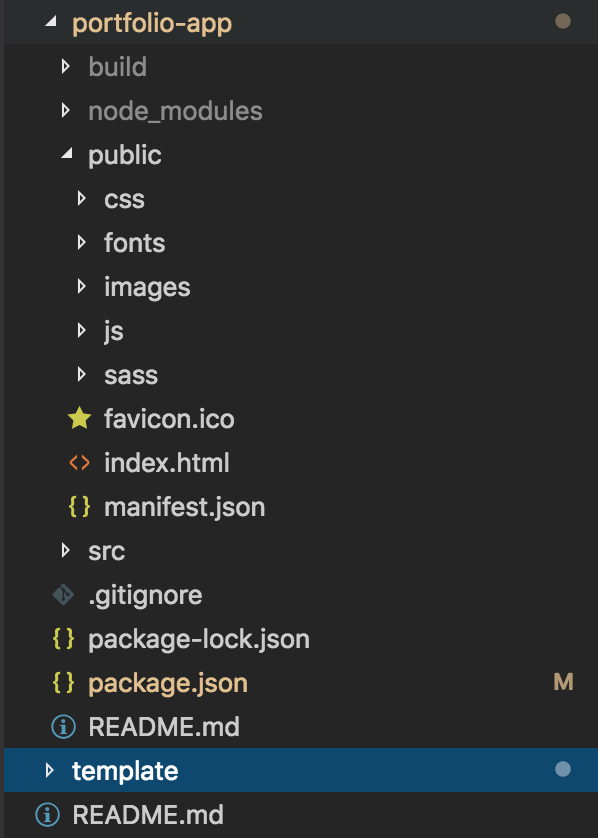How To Create Website Using React Js

After my friends canceled our weekend plans, I was looking for something to kill time. I finally ended up with a plan to create a portfolio website after going through my long pending list of 'Wish-To-Do' things.
Many hours of searching for technologies and templates later, I ended up creating this website using React.js and deploying it using Github pages. You can find the code for the website here (It's called a 'web-app' technically, but for this article, I will be referring to it as a 'website' … I hope that's ok).
What you will learn
- Some basic concepts of React.js
- How to use create-react-app from an HTML website
- How to deploy your portfolio website using 'Github pages'
Some concepts you need to know before we start ..
Note — feel free to skip this part if you are already familiar with basic concepts of React.js and React Components.These points will provide a very basic idea of the React world. I highly recommend you to study more about React from the documentation and get hands-on with the help of freeCodeCamp.
What is React.js >
For now, it is enough to know that React.js is the JavaScript library used for building UI components. It was created by the engineers of Facebook and nowadays, it is rocking the JavaScript world..
What is a React Component >
React lets you define components as a class or a function. You can provide optional inputs to the components called 'props'.
Components let you split up the UI into independent sections like header, footer, and body. Each component will work independently so any individual component can be rendered independently into the ReactDOMwithout affecting the whole page.
It also comes with 'lifecycle methods' which let you define pieces of code you want to execute according to the state of the component like mounting, rendering, updating and un-mounting.
React components come with their own trade-offs. For example, we can reuse a component by exporting it to other components, but sometimes it gets confusing to handle multiple components talking and triggering renders for each other.
this is how a component would look like!
import React, { Component } from 'react' export default class Component-name extends Component { render() { return ( <div> {these code will be rendered into the DOM} </div> ) } } What is GitHub Pages >
With GitHub Pages, you can easily deploy your site using GitHub for free and without the need to set up any infrastructure. They have provided modules so that you don't have to worry about many things. If you stick around till the end you'll see that it works like MAGIC!
Before you go ahead make sure to ..
Decide what content you want to put up on your website
Go through your latest resume once (if you don't have one then create one now and postpone this project until next weekend ?). It will help you to have a clear idea about what kind of information you want to put on your portfolio website.
Find inspiration
Browse through the hundreds of free portfolio website templates on the web, see how and what you can use from them — take out a pen and paper and sketch out a rough diagram to get an idea of what your website will look like. I will be using this template to demonstrate.
Gather some amazing pictures of yourself
Of course you don't want to look bad on your own portfolio website. So dig into your archives of photos to find the perfect photos for your website.
Tune into your favourite playlist
Legend has it that good things come only with good music… and you surely don't want to miss out on any great things.

Let's jump into the building part
In the following sections, I will describe steps to building the portfolio app but you don't have to follow the same code I use. Focus on learning the concepts and show some creativity! Further reading has been divided into three sections.
- Setting up the React-app
- Breaking down the HTML page into React components
- Deploying your app onto Github pages
Setting up React-app
We will be using create-react-app — a module provided by Facebook — which helps us to create React.js apps with ease and without worrying about build tools.
- Go to the console and run
npm install create-react-appto install this module via npm (make sure that you have installednpmbefore using it — follow this link for more info). - Now run
npm create-react-app ${project-name}which will fetch build scripts and create a file-structure which will look like this.
my-portfolio-app ├── README.md (description of the project for GitHUb) ├── node_modules (stores all dependent modules for the project) ├── package.json (stores all meta information of the prokect like dependencies,version,revisions etc.) ├── .gitignore (files declared here will be ignored while uploading to GitHub like node_modules ├── public (here you will store all images,JS,CSS files) │ ├── favicon.ico │ ├── index.html │ └── manifest.json └── src (our main code for app lies here) ├── {create component folder here} ├── App.css ├── App.js ├── App.test.js ├── index.css ├── index.js ├── logo.svg └── serviceWorker.js Create a components folder under the src directory. This is where we will store our components in the future.
- Copy all the images, fonts, HTML and CSS files from the HTML
templateyou decided to work with into thepublicfolder.
Now your project directory should look like this.

- Run the
npm installcommand which will install dependent modules undernode_moduledirectory. - If you've got it right up until now, then running the
npm startcommand will start the React app on thelocalhost. Go tohttps://localhost:3000and you should be able to see the starter page of the React-app.
Breaking-down the HTML page into React components..
Remember the component folder which we created under src directory in the previous step, now we will break down the HTML template page into components and combine these components to make our React-app.
- First, you need to identify which components you can create from the monolithic HTML file — like header, footer and contact me. You need to be a little creative here!!
- Look for tags like section/div which aren't nested into some other section/div. These should contain code about that particular section of the page which is independent of other sections. Try looking into my GitHub Repo to get a better idea about this one.
Hint: Use the 'inspect element' tool to play around with the code and take notice of the effect of changes within the browser. - These pieces of HTML code will be used in the
render()method of the component. Therender()method will return this code whenever a component gets rendered into the ReactDOM. Take a look at the code blocks given below for reference.
<section id="colorlib-hero" class="js-fullheight" data-section="home"> <div class="flexslider js-fullheight"> <ul class="slides"> <li style="background-image: url(images/img_bg_1.jpg);"> <div class="overlay"></div> <div class="container-fluid"> <div class="row"> <div class="col-md-6 col-md-offset-3 col-md-pull-3 col-sm-12 col-xs-12 js-fullheight slider-text"> <div class="slider-text-inner js-fullheight"> <div class="desc"> <h1>Hi! <br>I'm Jackson</h1> <h2>100% html5 bootstrap templates Made by <a href="https://colorlib.com/" target="_blank">colorlib.com</a></h2> <p><a class="btn btn-primary btn-learn">Download CV <em class="icon-download4"></em></a></p> </div> </div> </div> </div> </div> </li> <li style="background-image: url(images/img_bg_2.jpg);"> <div class="overlay"></div> <div class="container-fluid"> <div class="row"> <div class="col-md-6 col-md-offset-3 col-md-pull-3 col-sm-12 col-xs-12 js-fullheight slider-text"> <div class="slider-text-inner"> <div class="desc"> <h1>I am <br>a Designer</h1> <h2>100% html5 bootstrap templates Made by <a href="https://colorlib.com/" target="_blank">colorlib.com</a></h2> <p><a class="btn btn-primary btn-learn">View Portfolio <em class="icon-briefcase3"></em></a></p> </div> </div> </div> </div> </div> </li> </ul> </div> </section> import React, { Component } from 'react' export default class Home extends Component { render() { return ( <div> <section id="colorlib-hero" className="js-fullheight" data-section="home"> <div className="flexslider js-fullheight"> <ul className="slides"> <li style={{backgroundImage: 'url(images/img_bg_1.jpg)'}}> <div className="overlay" /> <div className="container-fluid"> <div className="row"> <div className="col-md-6 col-md-offset-3 col-md-pull-3 col-sm-12 col-xs-12 js-fullheight slider-text"> <div className="slider-text-inner js-fullheight"> <div className="desc"> <h1>Hi! <br />I'm Jackson</h1> <h2>100% html5 bootstrap templates Made by <a href="https://colorlib.com/" target="_blank">colorlib.com</a></h2> <p><a className="btn btn-primary btn-learn">Download CV <em className="icon-download4" /></a></p> </div> </div> </div> </div> </div> </li> <li style={{backgroundImage: 'url(images/img_bg_2.jpg)'}}> <div className="overlay" /> <div className="container-fluid"> <div className="row"> <div className="col-md-6 col-md-offset-3 col-md-pull-3 col-sm-12 col-xs-12 js-fullheight slider-text"> <div className="slider-text-inner"> <div className="desc"> <h1>I am <br />a Designer</h1> <h2>100% html5 bootstrap templates Made by <a href="https://colorlib.com/" target="_blank">colorlib.com</a></h2> <p><a className="btn btn-primary btn-learn">View Portfolio <em className="icon-briefcase3" /></a></p> </div> </div> </div> </div> </div> </li> </ul> </div> </section> </div> ) } } Hint: If things are getting confusing on the react side — try focusing on the concept of 'how to identify wanna be components from the HTML codebase'. After getting comfortable with React, implementation will be a piece of cake.
Did you notice that there are some changes in the HTML code? class became className. These changes are required because React doesn't support HTML ? — they have come up with their own HTML-like JS syntax which is called JSX . So, we need to change some parts of the HTML code to make it JSX.
I bumped into this HTML to JSX converter during this project, which converts HTML code into JSX for you ?. I highly recommend using this rather than changing your code manually.
After some time, you should come up with some different components. Now the EndGame is near!! Combine these different components under one App.js component (YES!! You can render one component from another component!) and your portfolio app will be ready.
import React, { Component } from 'react'; import './App.css'; import Sidebar from './components/sidebar' import Introduction from './components/introduction' import About from './components/about' import Projects from './components/projects' import Blog from './components/blog' import Timeline from './components/timeline' class App extends Component { render() { return ( <div id="colorlib-page"> <div id="container-wrap"> <Sidebar></Sidebar> <div id="colorlib-main"> <Introduction></Introduction> <About></About> <Projects></Projects> <Blog></Blog> <Timeline></Timeline> </div> </div> </div> ); } } export default App; Notice in the above code that we need to first import the components in order to use them in the render() section. And we can use the components just by adding <component-name></component-name>or just <component-name/> tag in the render method.
- Run
npm startfrom your terminal and you should be able to see the changes reflected in the website. You don't need to run this command again if you have made more changes in the code, it will be reflected automatically when you save those changes. You can do some lightning fast development thanks to thehot reloadfeature. - Play around with the HTML and CSS to change the content according to your resume and make your portfolio even cooler by changing the content, trying out different fonts, changing the colours and adding photos of your choice.
Deploy React-app to Github pages
Okay, so you survived until this point… take a moment to appreciate your hard work. But you still need to complete your deployment so that you can share your cool work with your friends who ditched those weekend plans.
- First, you need to install the npm library of Github pages. To install, run this command
npm install gh-pageson your terminal.
Now, you need to make the following changes in your manifest.json file:
- Add the
homepagefield — value will be in the following format —https://{github_id}.github.io/{github_repo} - Add
predeployanddeployfields underscripts
Now your manifest.json should look like this:
{ "name": "portfolio-app", "version": "0.1.0", "private": true, "homepage": "https://Dhruv34788.github.io/me", "dependencies": { "gh-pages": "^2.0.1", "react": "^16.8.3", "react-dom": "^16.8.3", "react-scripts": "2.1.5", "yarn": "^1.13.0"}, "scripts": { "start": "react-scripts start", "build": "react-scripts build", "predeploy": "yarn run build", "deploy": "gh-pages -d build", "test": "react-scripts test", "eject": "react-scripts eject"}, "eslintConfig": { "extends": "react-app"}, "browserslist": [ ">0.2%", "not dead", "not ie <= 11", "not op_mini all" ] } Now go to the terminal, run npm run deploy and wait for the magic!! Your app will be deployed after the deployment scripts execute successfully. Verify whether your app has deployed or not by visiting the link you provided in the homepage field.
Caution: Please be careful when deploying anything onto the web. Perform safety checks like removing internal links, passwords, or anything that you don't want to be there in the hands of smart people out there.
If you are going to make changes often...
Note — You need to perform the deployment stage every time you change something and if you are making changes in the codebase - guess what whose going to get bored soon !! ( No worries I got your back :P)You can automate the deployment process using Travis-CI (automation tool), so that if you commit anything into master branch – the deployment steps will be triggered and new site will be automatically available. Follow this article for that.
https://www.freecodecamp.org/news/learn-how-to-automate-deployment-on-github-pages-with-travis-ci/
Homework for you ..
Congratulations! You have finally created and deployed your portfolio app. If you are interested, then you can add these features to your website
- Blog feature: create your own blog using Node.js and a NoSQL database like MongoDB and merge it into this portfolio website.
- Gallery: add a section to the page where you can show the screenplay of the recent photos from your social media websites.
- Twitter Feed: add a section showing recent tweets by you.
- Random Quote: add a section showing some random motivational quotes.
If you implement any of these features, share your work with me. I would be more than happy to help ? ( if I can ?)
Wrapping up ..
I would like to take a moment to acknowledge the work of the people who gave me the inspiration and knowledge to complete this article.
- Quincy Larson, Sahat Yalkabov & community: For creating freeCodeCamp — the platform where you can learn and gain knowledge about almost everything related to web technologies; using hands-on tutorials and all without paying fees. ?
- Colorlib: for providing state of the art templates which were a huge inspiration for my portfolio website. ?
- Daniel Lo Nigro & community: for creating HTML to JSX Compiler, which turned out to be handy while converting HTML blocks into JSX code. ?
- My dearest friends: who helped me in correcting my mistakes.
- YOU: for sticking around, I hope you had a productive time. Keep exploring and building amazing things!

Learn to code for free. freeCodeCamp's open source curriculum has helped more than 40,000 people get jobs as developers. Get started
How To Create Website Using React Js
Source: https://www.freecodecamp.org/news/portfolio-app-using-react-618814e35843/
Posted by: garrendoperelpland.blogspot.com

0 Response to "How To Create Website Using React Js"
Post a Comment